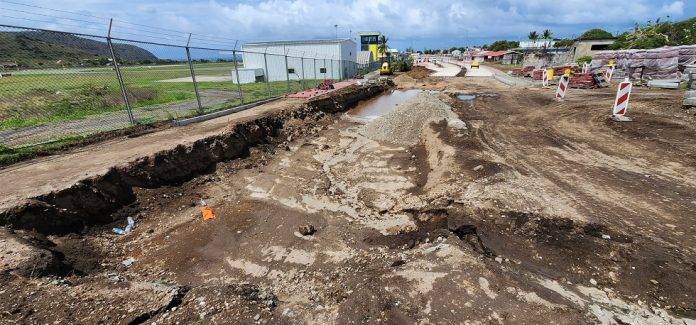ORANJESTAD, Sint Eustatius — Earlier this week the news came out that around July 18 construction company Statia Roads & Construction severely destroyed the archaeological site associated with what is believed to be the enslaved Afrikan village area of the former Golden Rock plantation on St. Eustatius. The board of the St. Eustatius Center for Archaeological Research (SECAR) on the island granted permission to the building contractors to continue digging after the Airport Boulevard project manager had concerns while the contractors were testing the soil. However, none of the board members is qualified to take this decision. SECAR’s director and archaeologist Mr.Budsberg was off-island at that time.
According to Budsberg approximately one third of the area was irrevocably destroyed. The loss of knowledge for the descendant community of their ancestral heritage is indescribable. The SECAR board denies that they gave permission. The Culture Department of St. Eustatius government halted the digging and is investigating the events.
Damaging outcome research report on controversial excavations 2021
The report of the Statia Heritage Research Commission (SHRC) that was published in January 2022 revealed that SECAR deliberately misinformed the descendants and broader communities of St. Eustatius of the excavations of the ancestral remains of the former Golden Rock plantation burial ground. The SHRC report concluded that the director of SECAR, Mr. Stelten, “did not see the far more significant issues of emotional attachment and affinity for the human remains of St. Eustatius’s ancestors, nor did they see the vital role that ancestors have for the surviving population of St. Eustatius today.”
The excavations of 69 human remains of enslaved Afrikans at the Golden Rock Afrikan burial ground in 2021 made headlines throughout the world with a deceptive public relations campaign. After the publication of the damaging report on SECAR’s role in these excavations, the director Ruud Stelten left. However, SECAR’s board continued business as usual and claimed it was not to blame for what happened.
SECAR’s shady reputation
The SECAR board consists of seven people: four Americans, two Dutch, and only one Statian from the island. Three board members, including the President, have served on the board since 2008. SECAR has a reputation for marginalizing descendants and the broader Statian community where it concerns making accessible information about the findings of archaeological excavations and sites. Additionally, artifacts retrieved from excavations are rendered inaccessible, and are stored in unknown locations and unknown conditions. On an island full of archaeological sites, this is a deeply disturbing state of affairs, particularly in light of SECAR’s questionable practices in the ethical treatment of Afrikan cultural heritage resources and descendant community engagement. To add insult to injury, in a recent television documentary, SECAR’s President Soutekouw makes offensive and derogatory statements about the Statian people.
Lack of political will to protect marginalized Afrikan cultural heritage
The area under excavation is part of St. Eustatius’ multi-million dollar airport boulevard redevelopment and is believed to be the former village for enslaved Afrikan people associated with the Golden Rock Plantation. While many St. Eustatius residents hail the new boulevard as progress, others remain skeptical. Alliance President Kenneth Cuvalay belongs to the group of skeptics: “Why would we need these big roundabouts where more cows pass than cars? Poverty is high on St. Eustatius and there is still no social minimum. Nevertheless, the Dutch government decides to invest heavily in infrastructure, let people live in poverty, and by lacking appropriate legislation makes the destruction of our cultural heritage incredibly simple.”
Slavery apologies by Dutch state: put the money where the mouth is
Cuvalay: “I was shocked to hear about the destruction of what is probably an excavated village of my ancestors, to learn about the treatment of our Afrikan ancestors’ sacred burial grounds and cultural heritages that continue to be looted, destroyed and displaced worldwide by colonial powers within the industry of archaeology and in many other ways, without respect, without dignity and bypassing the Afrikan descendants communities. Not everyone on the island can or dare to speak out so we will be their voice as well.”
“Dutch Prime Minister Mark Rutte and the Dutch government leadership have fallen short where it concerns implementing critical measures for cultural heritage protection and repair, despite publically acknowledging the Dutch State’s role in global slavery, atrocities and crimes against the Afrikan people as a “crime against humanity”. Today, the treatment of our cultural heritage and black cultural identity through the destruction of our Afrikan historical cultural heritages, is a continuation of that crime.”
Alliance file complaints and wants dissolvement of SECAR
SECAR should be dissolved, according to the St. Eustatius Afrikan Burial Ground. It is a monster of the colonial past, a symbol of exploitation, and marginalization of Afrikan cultural heritage. There should be a new archaeological organization, a new board, and a new -more tailored- government mandate. The Alliance will file a complaint to the local government, the Dutch Ministry of Education, Culture and Science (in Dutch: OCW), UNESCO, and the UN Permanent Forum on People of African Descent.
Cuvalay urges everyone to send a protest message to SECAR (secarstatia@gmail.com) and calls on the SECAR board to finally step down if they have any sense of moral and ethics.






























